
Acinonyx is a genus within the Felidae family. The only living species of the genus, the cheetah, lives in open grasslands of Africa and Asia.

Diceros is a genus of rhinoceros containing the extant black rhinoceros (Diceros bicornis) and several extinct species.
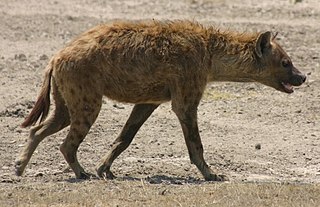
Crocuta is a genus of hyena containing the largest extant member of the family, the spotted hyena (Crocuta crocuta). Several fossil species are known as well.
Hadar or Hadar Formation is a paleontological fossil site located in Mille district, Administrative Zone 1 of the Afar Region, Ethiopia, 15 km upstream (west) of the A1 road's bridge across the Awash River.

Aepyceros is a genus of African antelope that contains a single living species, the impala. It is the only known member of the tribe Aepycerotini.
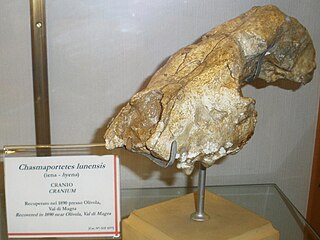
Chasmaporthetes, also known as hunting or running hyena, is an extinct genus of hyenas distributed in Eurasia, North America, and Africa during the Pliocene-Pleistocene epochs, living from 4.9 million to 780,000 years ago, existing for about 4.12 million years. The genus probably arose from Eurasian Miocene hyenas such as Thalassictis or Lycyaena, with C. borissiaki being the oldest known representative. The species C. ossifragus was the only hyena to cross the Bering land bridge into the Americas, and ranged over what is now Arizona and Mexico during Blancan and early Irvingtonian Land Mammal ages, between 5.0 and 1.5 million years ago.
Nyctereutes abdeslami is an extinct relative of the raccoon dog from the Pliocene. A jaw from the species was found in Morocco. Scientists have noticed that Nyctereutes abdeslami had much larger molars than other species of its genus, suggesting a larger body.
The turnover-pulse hypothesis, formulated by paleontologist Elisabeth Vrba, suggests that major changes to the climate or ecosystem often result in a period of rapid extinction and high turnover of new species across multiple different lineages. Changes may include climate change, tectonic plate shifting, and catastrophes, among other things. It can be seen as an extension of the concept of evolutionary radiation from a single to a multi-clade context.

Kolpochoerus is an extinct genus of the pig family Suidae related to the modern-day genera Hylochoerus, Phacochoerus, and Potamochoerus. It is believed that most of them inhabited African forests, as opposed to the bushpig and red river hog that inhabit open brush and savannas. There are currently eleven recognized species.
Ahl al Oughlam is an archaeological site and palaeontological site located just outside Casablanca, Morocco. It was discovered in 1985 and first excavated in 1989. Ahl al Oughlam is the richest late Neogene vertebrate locality of North Africa. It has also yielded the area's first important carnivore fauna, including 23 taxa, 13 of which are new.

The Asian or Asiatic ostrich, is an extinct species of ostrich that lived during the Neogene period on the Indian subcontinent.

Chilotherium is an extinct genus of rhinocerotids endemic to Eurasia during the Miocene through Pliocene living for 13.7—3.4 mya, existing for approximately 10.3 million years.

Ontocetus is an extinct genus of walrus, an aquatic carnivoran of the family Odobenidae, endemic to coastal regions of the southern North Sea and the southeastern coastal regions of the U.S. during the Miocene-Pleistocene. It lived from 13.6 mya—300,000 years ago, existing for approximately 13.3 million years.
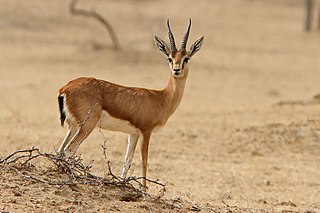
A gazelle is one of many antelope species in the genus Gazella. There are also seven species included in two further genera; Eudorcas and Nanger, which were formerly considered subgenera of Gazella. A third former subgenus, Procapra, includes three living species of Asian gazelles.

Ceratotherium neumayri is a fossil species of rhinoceros from the Late Miocene (Vallesian-Turolian) of the Balkans and Western Asia, with remains known from Greece, Bulgaria, Iran, and Anatolia in Turkey.
Acinonyx aicha is an extinct felid species belonging to the genus Acinonyx. It was first described in 1997 based on fossils from the Pliocene of Morocco.
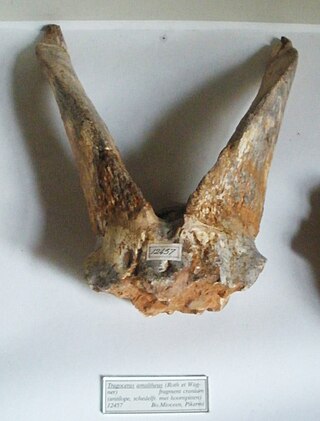
Tragoportax is an extinct genus of bovid ungulate. It lived during the upper Miocene, and its fossils have been found in Europe, Asia and Africa. Tragoportax is sometimes considered to have been a close relative of the extant nilgai, though it may have formed its own subfamily, along with Miotragocerus.
Diceros praecox is an extinct species of rhinoceros that lived in Africa during the Pliocene, around 4 million years ago. It has been suggested to be the direct ancestor of the living black rhinoceros (Diceros bicornis).

Dolichopithecus is an extinct genus of Old World monkey that lived in Europe during the Late Miocene and Pliocene.
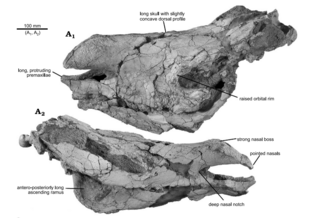
Eoazara xerrii is a species of extinct elasmotheriine rhinoceros from the upper Miocene of Morocco, the first definitive representative of the subfamily in North Africa. It is known from a well preserved skull and postcranial material, preserving the most complete late Miocene rhino skull found in Africa.














